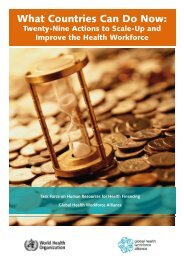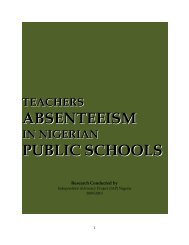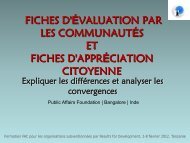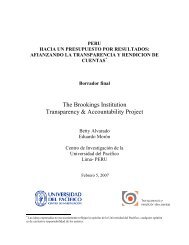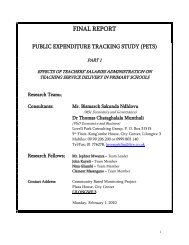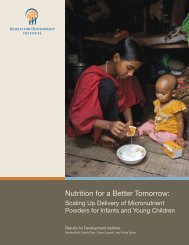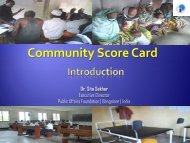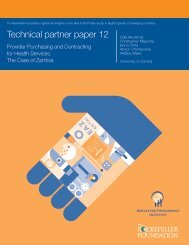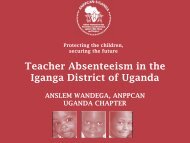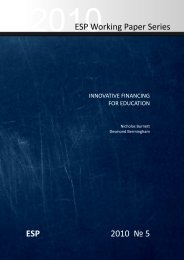Innovative Secondary Education For Skills Enhancement
Innovative Secondary Education For Skills Enhancement
Innovative Secondary Education For Skills Enhancement
Create successful ePaper yourself
Turn your PDF publications into a flip-book with our unique Google optimized e-Paper software.
There is much overlap between<br />
[21st-century skills] and what<br />
employers seek from school leavers<br />
in developing countries.<br />
operation and Development (OECD) defines as the ability<br />
to apply skills in a specific context (OECD 2005).<br />
In recent years, much attention has been given to so-called<br />
21st-century skills, especially in OECD countries. These<br />
have been variously described in different documents, as<br />
developed by different institutions including the World<br />
Bank, the Partnership for 21st Century <strong>Skills</strong> in the United<br />
States, and corporate collaborations like ATC21S (the Assessment<br />
and Teaching of 21st Century <strong>Skills</strong> project at the<br />
University of Melbourne in Australia). This has stemmed<br />
from two factors: the growing prevalence of information<br />
and communications technology (ICT) throughout all<br />
economies and rising youth unemployment. These skills<br />
generally fall into four categories:<br />
• core subjects (the three Rs [3Rs], or basic literacy and<br />
numeracy plus 21st-century themes such as global<br />
awareness and health literacy);<br />
• life and career skills (flexibility and adaptability, initiative<br />
and self-direction, social and cross-cultural skills,<br />
productivity and accountability, leadership and responsibility);<br />
• learning and innovation skills (critical thinking, communication,<br />
collaboration, creativity); and<br />
• information, media, and technology skills.<br />
This paper does not use this list of skills as such, but, as<br />
will be apparent, there is much overlap between them<br />
and what employers seek from school leavers in developing<br />
countries. Many of the skills on the 21st-century list<br />
are also often collected together into various packages of<br />
“life skills” that are considered important. In Thailand,<br />
for example, life skills include creativity, industriousness,<br />
problem-solving, and workplace discipline. There is thus<br />
a significant convergence, though not a complete one, between<br />
the skills considered important in OECD countries<br />
and those in developing ones.<br />
correlates inversely with country per capita incomes. At<br />
the regional level, therefore, sub-Saharan African countries<br />
tend to have the largest informal economies, followed by<br />
Europe and Central Asia, Latin America and the Caribbean,<br />
the Middle East and North Africa, and South Asia,<br />
whereas OECD countries have the smallest informal economies.<br />
Globally speaking the share of the informal sector<br />
in total gross domestic product has decreased in most<br />
economies over recent decades, while its absolute size has<br />
grown substantially. Informal workers make up 49 percent,<br />
or half, of non-agricultural workers in 33 developing<br />
countries with available data (ILO 2011). Unfortunately<br />
most countries exclude agriculture from their measurements<br />
of informal economic activities, despite agriculture<br />
dominating employment in low-income countries (54<br />
percent in India and 70 percent in Senegal, for instance).<br />
Methodology<br />
R4D worked closely with five partners in Africa and Asia<br />
to understand the demand and supply side of the employability<br />
issue, exploring both the skills needed for employability<br />
in both the formal and informal sector and the<br />
skills students currently possess via the secondary education<br />
system. Answering both questions permitted a better<br />
understanding of the skills mismatch and a clearer idea of<br />
what is needed to close the gap. Twelve focus countries<br />
were selected in each region for the research, covering<br />
Francophone Africa, East Africa, South Asia, and Southeast<br />
Asia. Eighty-three enterprises in a mix of sectors were<br />
surveyed across sub-Saharan Africa (Figure 2), with twothirds<br />
being small and medium-sized enterprises (SMEs).<br />
In Southeast Asia, 21 employers were directly surveyed in<br />
Vietnam, while 2008 employer survey data were obtained<br />
from the Cambodian Federation of Employers and Business<br />
Associations and the Thailand Labor Demand of Establishment<br />
Survey. The former surveyed 220 enterprises<br />
while the latter covered 190,024 enterprises. Meanwhile,<br />
87 leaders from high-growth sectors were interviewed in<br />
focus groups across five cities in South Asia (specifically,<br />
Dhaka, Delhi, Bhopal, Mumbai, and Lahore). In addition,<br />
R4D, with support from the Rockefeller Foundation,<br />
convened a meeting in Bellagio, Italy, in July 2012 with 20<br />
experts from multilateral banks, United Nations agencies,<br />
the private sector, and foundations to discuss preliminary<br />
findings. Based on those discussions, the research was<br />
further refined.<br />
The term “informal economy” is used in this paper to<br />
refer to all economic activities by workers and economic<br />
units that are—either in law or in practice—not covered<br />
or insufficiently covered by formal arrangements (ILO<br />
2002). The relative size of the informal economy roughly<br />
8 <strong>Innovative</strong> <strong>Secondary</strong> <strong>Education</strong> <strong>For</strong> <strong>Skills</strong> <strong>Enhancement</strong> (ISESE)



